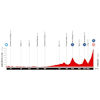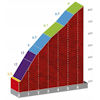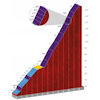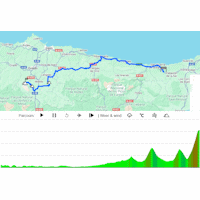While the stage is long, the early part of the course is relatively uneventful. The riders roll across flat roads as they make their way from Cantabria to Asturias. It’s only after nearly 150 kilometres that the first significant challenge appears: the Alto de Mozqueta, a 6.6-kilometre climb at 8.4%. The gradients are especially unforgiving in its opening stretches, providing a taste of what’s to come.
With around 25 kilometres remaining, the foor of the Alto de Cordal signals the start of the finale. Stretching 5.4 kilometer at 9.2%, it’s an ideal warm-up for the Angliru. Half of the climb it ramps up at double digits, making it a tough test in its own right.
The riders fly down into La Vega, where the main course is served up: the Alto de El Angliru. The climb is 12.4 kilometres long, but it’s fair to say there are really three Angliru’s. The first 5 kilometres go up at 8%, followed by a relatively flat kilometre. But the second half is where the real horror begins, with an average gradient of 15%. Riders face the steepest sector of 23.5% – aptly named Cueña les Cabres (goat path) – with 3 kilometres remaining.
La Vuelta last visited the Angliru in 2023. It was the stage where Primoz Roglic, riding for Jumbo-Visma, couldn’t dislodge his teammate Sepp Kuss from the red jersey. The Slovenian did, however, take the stage victory, with Jonas Vingegaard finishing second and Sepp Kuss in third. Those were indeed the glory days for the ‘Jumbo Bees’.
Other stage winners on the Angliru are Hugh Carthy (2020), Alberto Contador (2017, 2008), Kenny Elissonde (2013), Wout Poels (2011, after Juan José Cobo’s doping ban), Roberto Heras (2002), Gilberto Simoni (2000), and José María Jiménez (1999).
Vuelta a España 2025 stage 13: route, profile, videos
Click on the images to zoom







